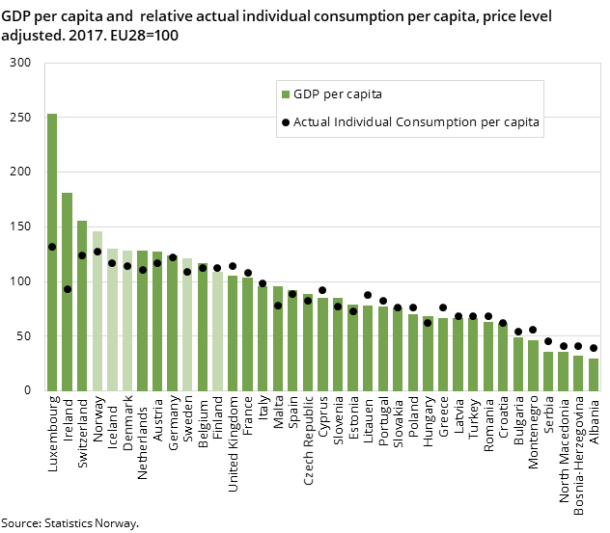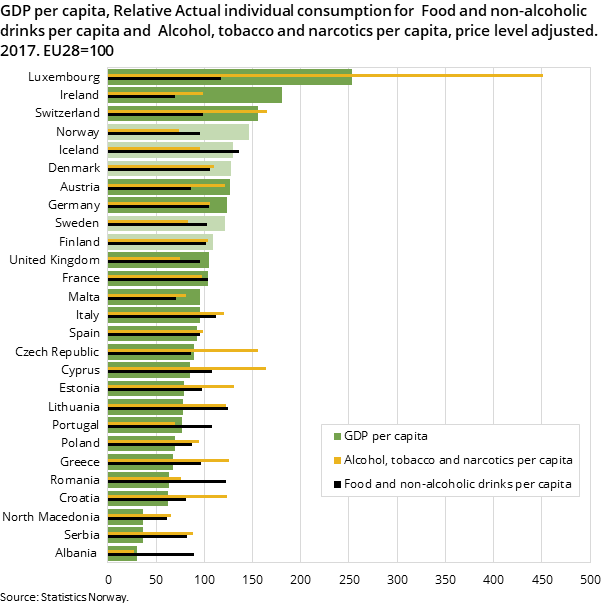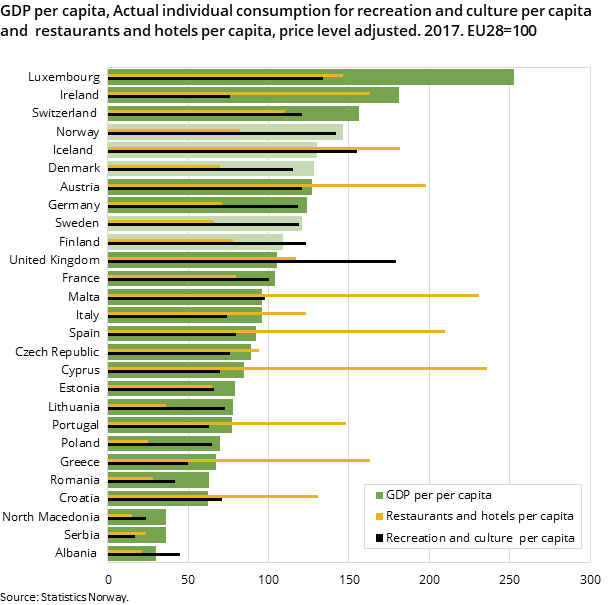Norway has second highest consumption level in Europe
Published:
In 2017, Luxembourg and Norway were ranked highest in terms of actual individual consumption per capita in Europe. In the Nordic countries, Iceland had the highest consumption levels for food and non-alcoholic drinks.
- Full set of figures
- Comparison of price levels in Europe
- Series archive
- Comparison of price levels in Europe (archive)
If we compare actual individual consumption (AIC), only Luxembourg consumed more than Norway in 2017. Luxembourg’s consumption level was 32 per cent above the EU average, while Norway was 27 per cent above the EU average; 8 to 16 per cent higher compared to other Nordic countries. The figures are from the latest European Comparison Programme.
In countries with a high GDP per capita, actual individual consumption per capita is often high, as seen in figure 1. The Nordic countries are amongst the top 12 in both actual individual consumption and price-adjusted GDP per capita. However, there are exceptions, and this is clearly seen for Ireland and Luxembourg. Despite Ireland having the second highest GDP per capita in Europe (see Eurostat publication ), it was only ranked 15th according to actual individual consumption per capita, with relative actual individual consumption 7 per cent lower than the European average. This can partly be explained by the large portion of the income generated in Ireland being sent out of the country by foreign owners. In the case of Luxembourg, a significant share of the country’s workforce lives in neighbouring countries. This group’s income therefore contributed to the GDP but the group was not included in the population count, and consequently their income did not lower the GDP per capita.
Iceland tops consumption of food and non-alcoholic drinks
Iceland had the highest consumption per capita for the group food and non-alcoholic drinks in 2017, 36 per cent higher than the EU28 average. Consumption was also high in Lithuania, Romania and Luxembourg. The other Nordic countries consumed just over the EU average, while Norway’s food and non-alcoholic drinks consumption was 4 per cent below the EU average. It is interesting to note that countries with a lower price level-adjusted GDP per capita consumed more for the group food and non-alcoholic drinks than countries with higher GDP levels, see figure 2.
Alcohol and tobacco in Luxembourg
Several countries levy high taxes on alcohol and tobacco, which affects consumption levels. In 2017, Luxembourg’s consumption of alcohol and tobacco was 4.5 times higher than the rest of Europe. A possible reason could be that consumption of non-resident customers may be included in the figures for Luxembourg. Switzerland, Cyprus and the Czech Republic were next, with a relative personal consumption of 65, 64 and 56 per cent above the EU average. Norway, Sweden and Iceland’s consumption for this group is 26, 17 and 5 per cent below the EU average, while Denmark and Finland were 10 and 4 per cent above. Albania had the lowest consumption, at around 70 per cent below that of the rest of Europe.
However, comparing the consumption of alcohol and tobacco between countries is complicated by differences in excise taxes for the different types of alcoholic drinks.
The United Kingdom consumed most for recreation and culture
Countries with the highest relative consumption for the group recreation and culture are United Kingdom, Iceland and Norway, with 79, 55 and 42 per cent above EU28 levels respectively. This group covers a wide range of goods and services for recreation, sport and culture. The other Nordic countries Finland, Sweden and Denmark consumed between 23 and 15 per cent above the EU average for recreation and culture.
Cyprus, Malta, Spain and Austria consumed more than double the EU average in the group restaurants and hotels in 2017. Other countries that used most for eating and overnight stays are Iceland, Greece and Ireland. High consumption levels in these countries can be partly explained by their traditions for dining out and socialising outside the home. At the bottom end of the scale is Albania, with the lowest actual individual consumption for restaurants and hotels, at 79 per cent below the EU28 average.
Contact
-
Estrellita Rauan
-
Birte Larsen Sandstå
-
Statistics Norway's Information Centre




